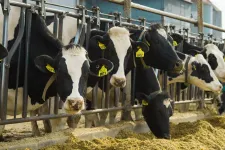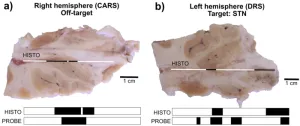(Press-News.org) URBANA, Ill. – The U.S. dairy industry operates a comprehensive data collection program that records herd production information from farmers nationwide. The program provides crucial input for cattle breeding and genetics, and its cooperative structure ensures benefits for producers and scientists alike. A new study from the University of Illinois explores the program’s century-old history, highlighting its relevance for modern agriculture and digital data collection.
“The National Cooperative Dairy Herd Improvement Program (NCDHIP) is an interesting case study because it illustrates how to translate the benefits of data collection for all dairy producers. Its model can serve as inspiration for other agricultural sectors,” says Jared Hutchins, assistant professor in the Department of Agricultural and Consumer Economics, part of the College of Agricultural, Consumer and Environmental Sciences at the U of I. Hutchins is lead author of the study, published in Applied Economic Perspectives and Policy.
The data collection program originally started in response to a new innovation in the dairy market. The Babcock test, introduced in 1890, provided a way to measure the butterfat composition of milk.
“Previously it was commonplace for dairy farmers to water down their milk to get paid more. But farmers were now paid on butterfat instead of milk weight. The Babcock test created a paradigm shift in dairy, giving producers an incentive to learn and fund research about this new metric,” Hutchins states.
With collection of herd production data, it became possible to evaluate which bulls sired the highest-producing cows – information that could only be obtained by aggregate results across farms. USDA scientists began using the data to publish bull evaluation lists, which dairy farmers could consult for breeding decisions.
The introduction of artificial insemination in the 1930s, and later the ability to freeze semen and ship it over large distances, dramatically increased the number of offspring each bull could produce. These new technologies greatly expanded the quantity of data available for breeding and genetics research, making it even more beneficial to producers.
The NCDHIP facilitates nationwide data collection through local Dairy Herd Improvement Associations (DHIAs). The first DHIA was established in 1905 by Helmer Rabild, a Danish immigrant who worked for the Michigan Department of Agriculture. He based the cooperative structure on milk testing cooperatives that existed in his native country of Denmark. Rabild was soon hired by the USDA to start DHIAs across the country, and the number of participating farmers rapidly increased.
Even with the proliferation of large farms in recent years, the program continues to be popular with producers. Hutchins says there are three key aspects which make the NCDHIP so successful.
“First, there are private benefits to producers, which makes them want to be a part of this system and contribute their data to the platform. There is power in scaling up, getting data from many different farmers, and producing value for the whole sector. But farmers also gain immediate benefits, such as a benchmarking report,” he notes.
Another crucial aspect is data interoperability, which means the program employs universal data standards that allow data across platforms to work with each other.
Finally, the cooperative data governance model gives producers control over how their data are used and processed. The NCDHIP is a collaborative agreement between the cooperatives, farmers, and the USDA.
“We often see a misalignment of the interests of data producers and the people that hold and use the data. The NCDHIP has solved this problem in a very clever way with the cooperative structure,” Hutchins states.
Other agricultural sectors may have one or two of these aspects, but Hutchins says dairy is unique in having all three, which is crucial for the system to work so well.
“We are currently in the midst of a digital revolution in agriculture, with so many novel ways to measure data. The question is what we do with the data, how it is controlled and managed, and how the benefits will be distributed. We wanted to show the dairy sector was able to leverage their data revolution in a way that benefited all dairy farmers,” Hutchins concludes.
The paper, “100 years of data sovereignty: Cooperative data governance and innovation in US dairy,” is published in Applied Economic Perspectives and Policy. Authors are Jared Hutchins and Brent Hueth. [https://doi.org/10.1002/aepp.13339]. This research was supported in part by the U.S. Department of Agriculture, Economic Research Service.
END
Dairy sector boasts 100 years of successful herd data collection
2023-03-23
ELSE PRESS RELEASES FROM THIS DATE:
Study: Mapping people’s knowledge of bees may aid in pollinator conservation
2023-03-23
UNIVERSITY PARK, Pa. — U.S. college students’ knowledge of bees focuses primarily on honey bees and pollination services, according to Penn State researchers, who said findings from their recent study could help in designing campaigns to generate support for protecting threatened pollinators.
Wild and managed bee populations have been in steep decline worldwide in recent years, noted study co-author Christina Grozinger, Publius Vergilius Maro Professor of Entomology and director of the Center for Pollinator Research in ...
Spectroscopy probe could enhance deep brain stimulation procedure for Parkinson’s
2023-03-23
VANCOUVER -- Deep brain stimulation (DBS) has become an increasingly common treatment for patients with advanced Parkinson’s disease, but the procedure still carries significant risks. A new probe that performs two types of spectroscopy could make the procedure safer and improve success rates by helping doctors more accurately navigate instruments inside the brain. The research team identified white and grey matter using principal component analysis (PCA), proving that spectroscopic measurements could be suitable for neuronavigation.
For DBS, surgeons place electrodes in the brain to disrupt the errant signals that cause debilitating tremors and stiffness associated ...
Habitat will dictate whether ground beetles win or lose against climate change
2023-03-23
UNIVERSITY PARK, Pa. — The success of North American crops from corn to Christmas trees partly depends on a relatively invisible component of the food web — ground beetles. Nearly 2,000 species of ground beetle live in North America. New research led by Penn State shows that some of these insects could thrive while others could decline as the climate changes. The team found that the response will largely depend on the species’ traits and habitats and could have significant implications for conservation efforts.
“We know that climate change influences everything from coral reefs in the ocean to trees on land, but there’s ...
CDC report shows overall and Maryland autism rate increase among 8-year-olds
2023-03-23
Researchers at the Johns Hopkins Bloomberg School of Public Health contributed to a new Centers for Disease Control and Prevention report that found a continued rise in the overall prevalence of autism among 8-year-olds in 2020, the year the data was collected, as well as notable sex and racial/ethnic trends. In Maryland, the autism rate among 8-year-olds also rose, but it was the lowest prevalence among 11 sites that contributed to the study.
Autism spectrum disorder (ASD) is a developmental disorder that can be characterized by social and communication challenges, along with limited interests and repetitive behaviors.
The prevalence of ASD has risen steadily ...
Court ruling on PrEP could lead to more than 2,000 HIV infections in the next year
2023-03-23
A recent U.S. federal court ruling that removes a requirement for employers to provide insurance coverage for the HIV prevention medications known as Pre-Exposure Prophylaxis, or PrEP, could result in more than 2,000 entirely preventable HIV infections in the coming year, according to a new study led by researchers at the Yale School of Public Health.
The study addresses the potential consequences of a September 2022 decision by U.S. District Judge Reed O’Connor of Texas in a case known as Braidwood Management v. Becerra. O’Connor ruled in favor of the plaintiffs, a group of Christian business owners who claimed that federal mandates requiring private insurance ...
USC Norris collaborates with Auransa on clinical trial of new targeted treatment for liver cancer and other solid tumors
2023-03-23
The University of Southern California (USC) is collaborating with Auransa Inc., on a phase 1 clinical trial to evaluate a new kind of treatment for cancers of the liver and solid tumors with liver dominant disease. The drug, known as AU409, was developed by Auransa, a clinical stage drug development company focused on identifying novel drug candidates for oncology, inflammatory diseases and diseases of the central nervous system. In preclinical trials, AU409, has been shown to work in a unique fashion by limiting the cancer cell’s ability to translate the message from various genes ...
Global natural history initiative builds groundbreaking database to address 21st century challenges
2023-03-23
March 23, 2023 – Washington, DC, New York, NY, and London, England – A group of natural history museums, organized by the Smithsonian National Museum of Natural History in Washington DC, the American Museum of Natural History Museum in New York City, and the Natural History Museum in London, has mapped the total collections from 73 of the world’s largest natural history museums in 28 countries. This is the first step of an ambitious effort to inventory global holdings that can help scientists and decisionmakers find solutions to urgent, wide-ranging issues such as climate ...
Eye color genes are critical for retinal health
2023-03-23
Metabolic pathways consist of a series of biochemical reactions in cells that convert a starting component into other products. There is growing evidence that metabolic pathways coupled with external stress factors influence the health of cells and tissues. Many human diseases, including retinal or neurodegenerative diseases, are associated with imbalances in metabolic pathways. Elisabeth Knust leads a team of researchers from the Max Planck Institute of Molecular Cell Biology and Genetics (MPI-CBG) in Dresden, Germany, who describe an essential role for one ...
Can insights from the soapbark tree change the way we make vaccines?
2023-03-23
The medicinal secrets of the Chilean soapbark tree have been laid bare, unlocking a future of more potent, affordable, and sustainably sought vaccines.
The evergreen species, Quillaja saponaria has, for decades, been highly prized for producing molecules called QS saponins, which are used in the food and drinks industry as foaming agents.
More recently an important new function has emerged with saponins obtained from the tree’s bark used as potent adjuvants in the production of vaccines. Adjuvants play a critical role in some vaccines, working to boost the potency of a vaccine by enhancing the host immune response.
Molecules extracted from soapbark tree are ...
Autism rates continue to rise in California
2023-03-23
A new report from the Centers for Disease Control and Prevention (CDC) shows the rates and demographics of children with autism spectrum disorder (ASD) are changing in the United States.
In the latest analysis, 1 in 36 8-year-old children (2.8%) have been identified as having ASD. This figure is higher than the previous estimate published in December 2021, which found a prevalence of 1 in 44 (2.3%) children, and considerably higher than the CDC’s first autism prevalence report published in 2007 noting a prevalence of 1 in 150 (0.7%).
Prevalence estimates also differed across the 11 data collection sites, ranging from 1 in 43 children (2.3%) in Maryland, to 1 in 22 (4.5%) ...






